Analyzing HRM at Aldi: Planning, Selection, and Effectiveness
VerifiedAdded on 2020/06/06
|12
|3470
|412
Report
AI Summary
This report provides a comprehensive analysis of Human Resource Management (HRM) practices at Aldi, a leading grocery retailer in the UK. It explores the role of HRM in planning and resourcing the organization's tasks, examining managerial and operative functions such as recruitment, selection, job analysis, performance appraisal, and training and development. The report also discusses the advantages and disadvantages of various employee selection methods used by Aldi. Furthermore, it evaluates the effectiveness of different HRM operations in promoting positive behavior, enhancing employee skills, and increasing productivity and profit. The significance of employee relations in decision-making is highlighted, emphasizing the importance of a healthy work environment, employee loyalty, and conflict reduction. The report concludes by underscoring the need for fair treatment and equitable practices to foster employee satisfaction and organizational success. Desklib provides access to this and many other solved assignments to aid students in their studies.
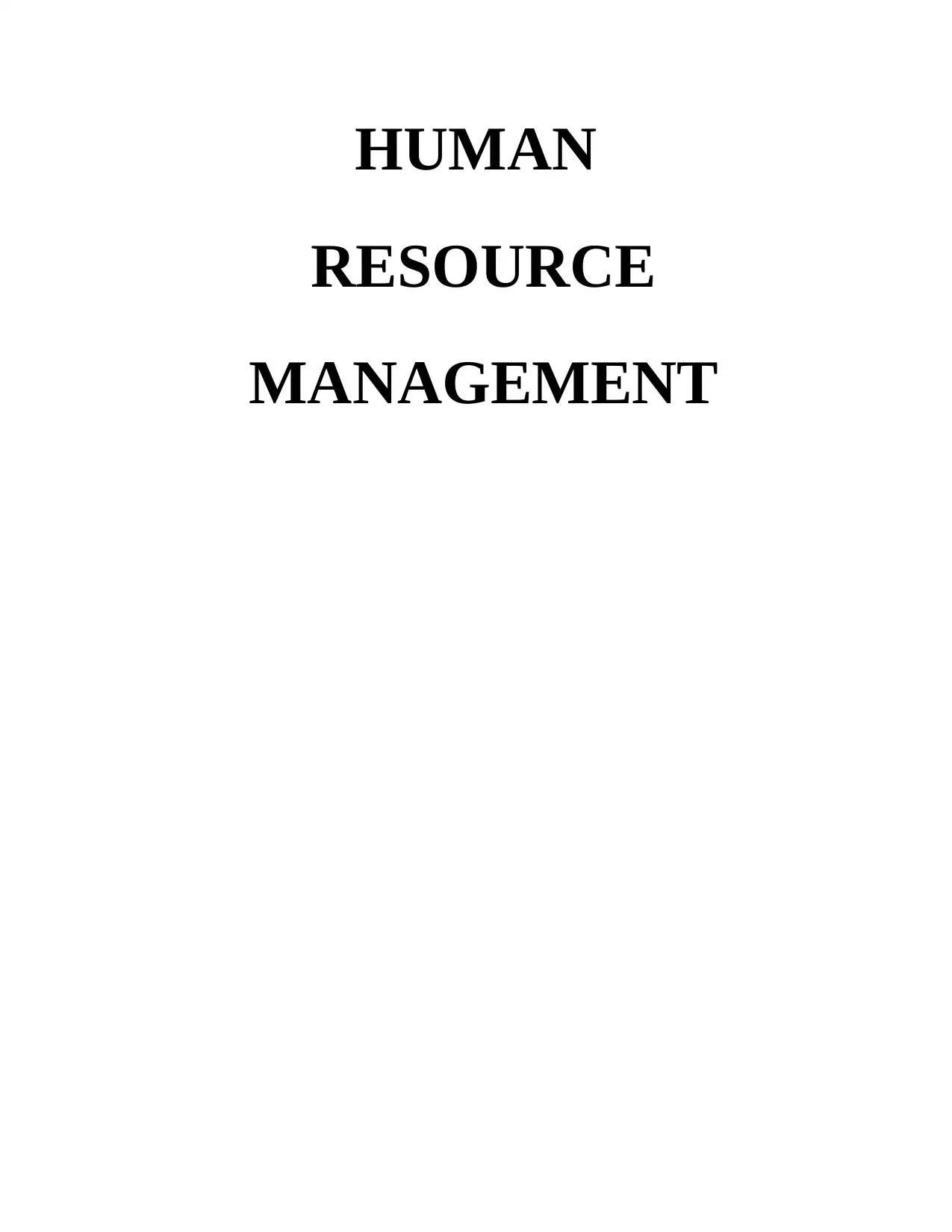
HUMAN
RESOURCE
MANAGEMENT
RESOURCE
MANAGEMENT
Paraphrase This Document
Need a fresh take? Get an instant paraphrase of this document with our AI Paraphraser
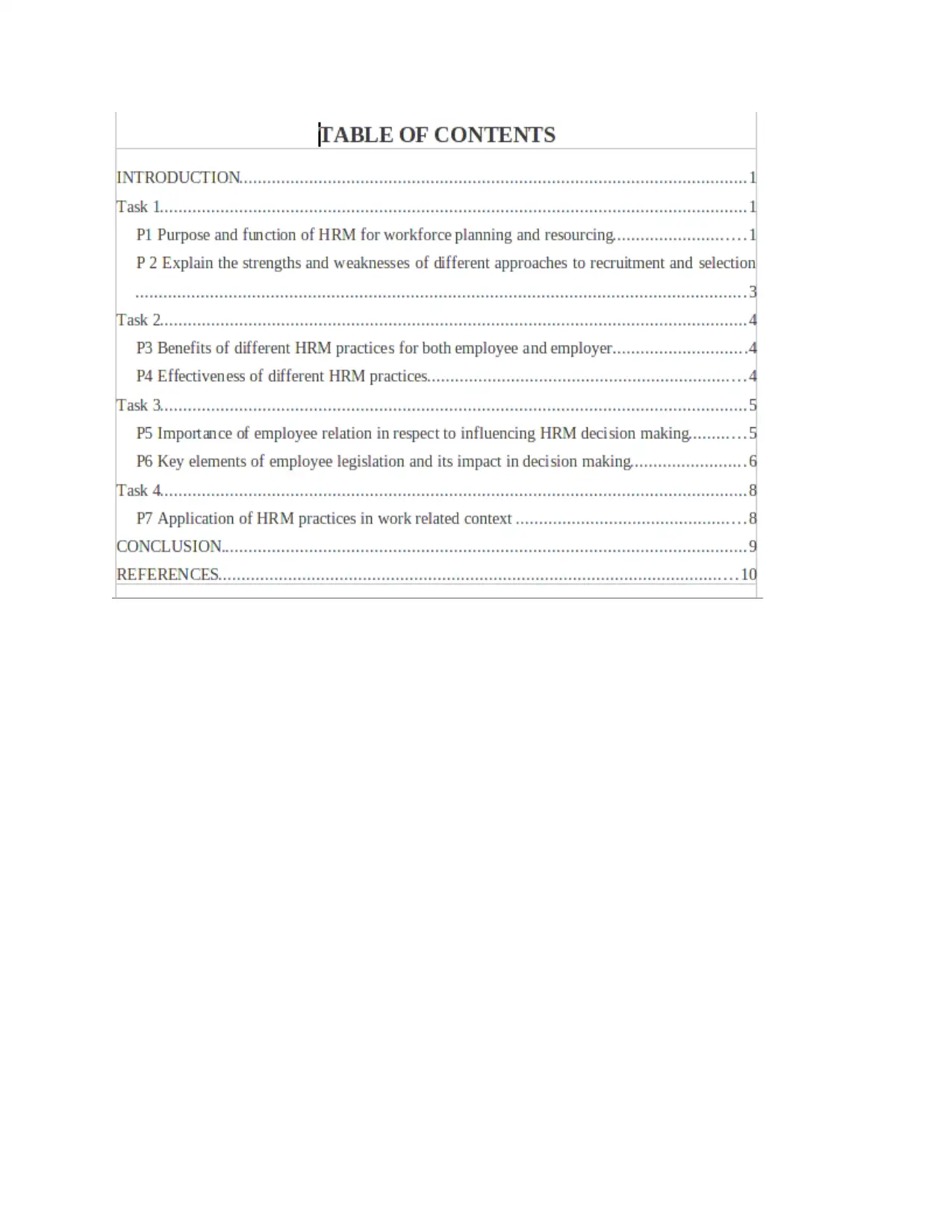
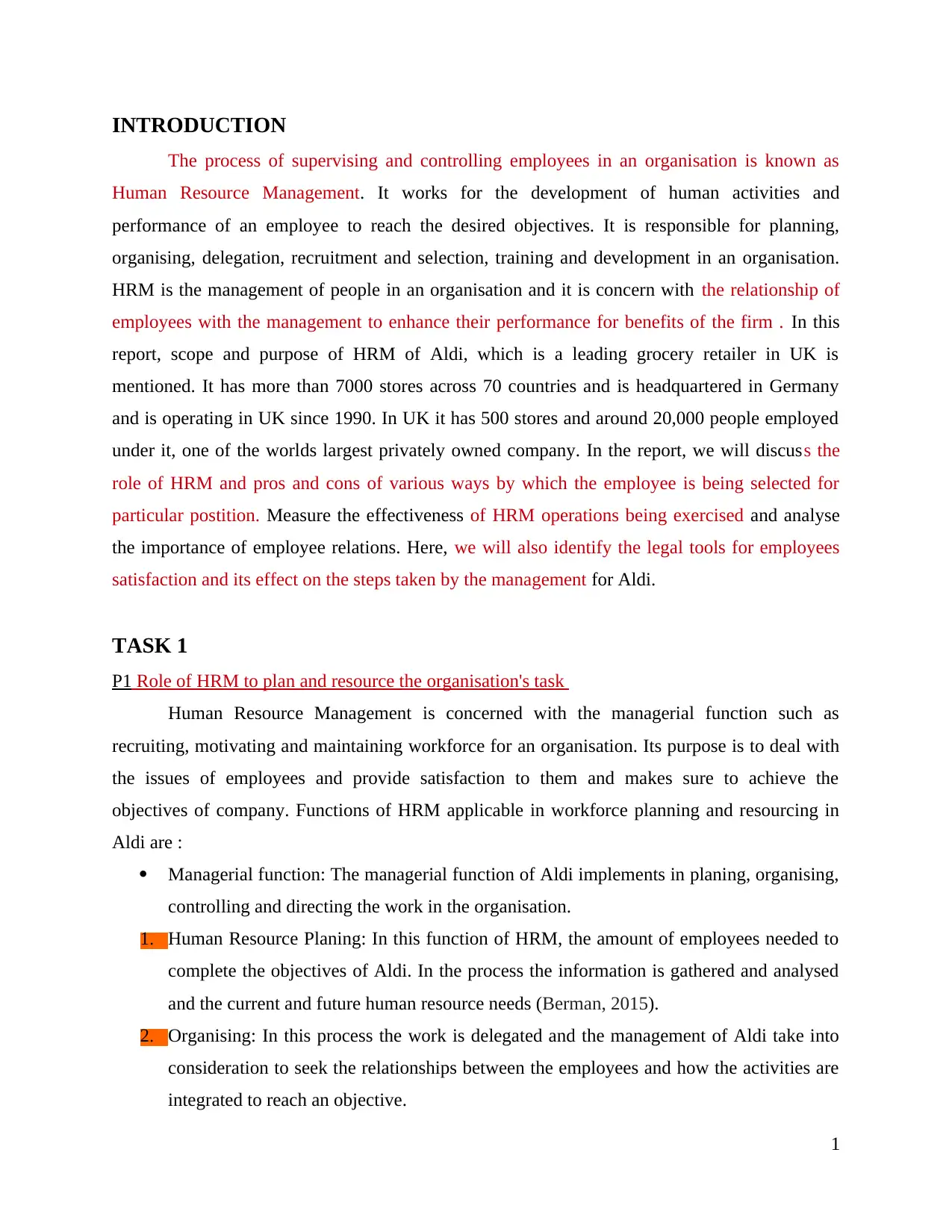
INTRODUCTION
The process of supervising and controlling employees in an organisation is known as
Human Resource Management. It works for the development of human activities and
performance of an employee to reach the desired objectives. It is responsible for planning,
organising, delegation, recruitment and selection, training and development in an organisation.
HRM is the management of people in an organisation and it is concern with the relationship of
employees with the management to enhance their performance for benefits of the firm . In this
report, scope and purpose of HRM of Aldi, which is a leading grocery retailer in UK is
mentioned. It has more than 7000 stores across 70 countries and is headquartered in Germany
and is operating in UK since 1990. In UK it has 500 stores and around 20,000 people employed
under it, one of the worlds largest privately owned company. In the report, we will discuss the
role of HRM and pros and cons of various ways by which the employee is being selected for
particular postition. Measure the effectiveness of HRM operations being exercised and analyse
the importance of employee relations. Here, we will also identify the legal tools for employees
satisfaction and its effect on the steps taken by the management for Aldi.
TASK 1
P1 Role of HRM to plan and resource the organisation's task
Human Resource Management is concerned with the managerial function such as
recruiting, motivating and maintaining workforce for an organisation. Its purpose is to deal with
the issues of employees and provide satisfaction to them and makes sure to achieve the
objectives of company. Functions of HRM applicable in workforce planning and resourcing in
Aldi are :
Managerial function: The managerial function of Aldi implements in planing, organising,
controlling and directing the work in the organisation.
1. Human Resource Planing: In this function of HRM, the amount of employees needed to
complete the objectives of Aldi. In the process the information is gathered and analysed
and the current and future human resource needs (Berman, 2015).
2. Organising: In this process the work is delegated and the management of Aldi take into
consideration to seek the relationships between the employees and how the activities are
integrated to reach an objective.
1
The process of supervising and controlling employees in an organisation is known as
Human Resource Management. It works for the development of human activities and
performance of an employee to reach the desired objectives. It is responsible for planning,
organising, delegation, recruitment and selection, training and development in an organisation.
HRM is the management of people in an organisation and it is concern with the relationship of
employees with the management to enhance their performance for benefits of the firm . In this
report, scope and purpose of HRM of Aldi, which is a leading grocery retailer in UK is
mentioned. It has more than 7000 stores across 70 countries and is headquartered in Germany
and is operating in UK since 1990. In UK it has 500 stores and around 20,000 people employed
under it, one of the worlds largest privately owned company. In the report, we will discuss the
role of HRM and pros and cons of various ways by which the employee is being selected for
particular postition. Measure the effectiveness of HRM operations being exercised and analyse
the importance of employee relations. Here, we will also identify the legal tools for employees
satisfaction and its effect on the steps taken by the management for Aldi.
TASK 1
P1 Role of HRM to plan and resource the organisation's task
Human Resource Management is concerned with the managerial function such as
recruiting, motivating and maintaining workforce for an organisation. Its purpose is to deal with
the issues of employees and provide satisfaction to them and makes sure to achieve the
objectives of company. Functions of HRM applicable in workforce planning and resourcing in
Aldi are :
Managerial function: The managerial function of Aldi implements in planing, organising,
controlling and directing the work in the organisation.
1. Human Resource Planing: In this function of HRM, the amount of employees needed to
complete the objectives of Aldi. In the process the information is gathered and analysed
and the current and future human resource needs (Berman, 2015).
2. Organising: In this process the work is delegated and the management of Aldi take into
consideration to seek the relationships between the employees and how the activities are
integrated to reach an objective.
1
⊘ This is a preview!⊘
Do you want full access?
Subscribe today to unlock all pages.

Trusted by 1+ million students worldwide
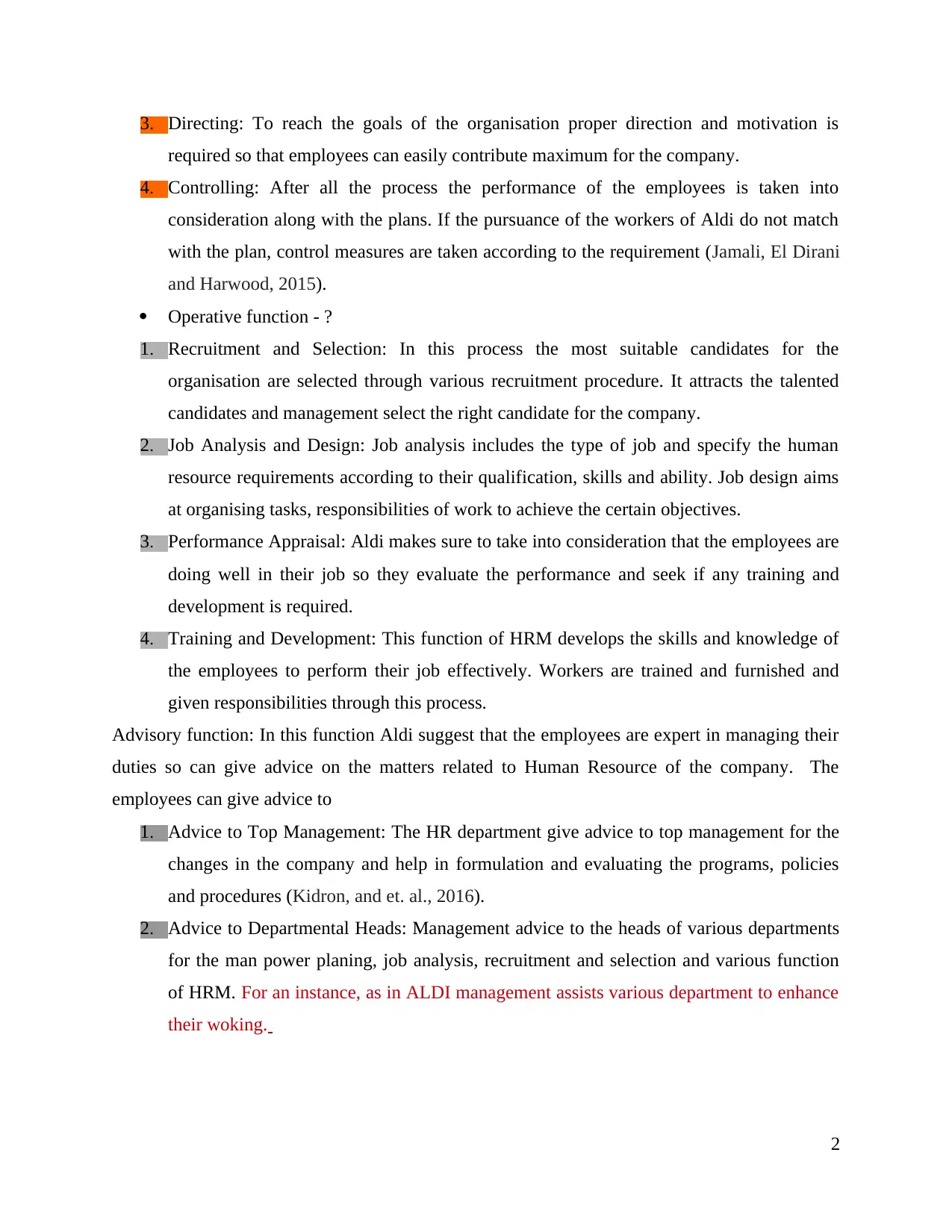
3. Directing: To reach the goals of the organisation proper direction and motivation is
required so that employees can easily contribute maximum for the company.
4. Controlling: After all the process the performance of the employees is taken into
consideration along with the plans. If the pursuance of the workers of Aldi do not match
with the plan, control measures are taken according to the requirement (Jamali, El Dirani
and Harwood, 2015).
Operative function - ?
1. Recruitment and Selection: In this process the most suitable candidates for the
organisation are selected through various recruitment procedure. It attracts the talented
candidates and management select the right candidate for the company.
2. Job Analysis and Design: Job analysis includes the type of job and specify the human
resource requirements according to their qualification, skills and ability. Job design aims
at organising tasks, responsibilities of work to achieve the certain objectives.
3. Performance Appraisal: Aldi makes sure to take into consideration that the employees are
doing well in their job so they evaluate the performance and seek if any training and
development is required.
4. Training and Development: This function of HRM develops the skills and knowledge of
the employees to perform their job effectively. Workers are trained and furnished and
given responsibilities through this process.
Advisory function: In this function Aldi suggest that the employees are expert in managing their
duties so can give advice on the matters related to Human Resource of the company. The
employees can give advice to
1. Advice to Top Management: The HR department give advice to top management for the
changes in the company and help in formulation and evaluating the programs, policies
and procedures (Kidron, and et. al., 2016).
2. Advice to Departmental Heads: Management advice to the heads of various departments
for the man power planing, job analysis, recruitment and selection and various function
of HRM. For an instance, as in ALDI management assists various department to enhance
their woking.
2
required so that employees can easily contribute maximum for the company.
4. Controlling: After all the process the performance of the employees is taken into
consideration along with the plans. If the pursuance of the workers of Aldi do not match
with the plan, control measures are taken according to the requirement (Jamali, El Dirani
and Harwood, 2015).
Operative function - ?
1. Recruitment and Selection: In this process the most suitable candidates for the
organisation are selected through various recruitment procedure. It attracts the talented
candidates and management select the right candidate for the company.
2. Job Analysis and Design: Job analysis includes the type of job and specify the human
resource requirements according to their qualification, skills and ability. Job design aims
at organising tasks, responsibilities of work to achieve the certain objectives.
3. Performance Appraisal: Aldi makes sure to take into consideration that the employees are
doing well in their job so they evaluate the performance and seek if any training and
development is required.
4. Training and Development: This function of HRM develops the skills and knowledge of
the employees to perform their job effectively. Workers are trained and furnished and
given responsibilities through this process.
Advisory function: In this function Aldi suggest that the employees are expert in managing their
duties so can give advice on the matters related to Human Resource of the company. The
employees can give advice to
1. Advice to Top Management: The HR department give advice to top management for the
changes in the company and help in formulation and evaluating the programs, policies
and procedures (Kidron, and et. al., 2016).
2. Advice to Departmental Heads: Management advice to the heads of various departments
for the man power planing, job analysis, recruitment and selection and various function
of HRM. For an instance, as in ALDI management assists various department to enhance
their woking.
2
Paraphrase This Document
Need a fresh take? Get an instant paraphrase of this document with our AI Paraphraser
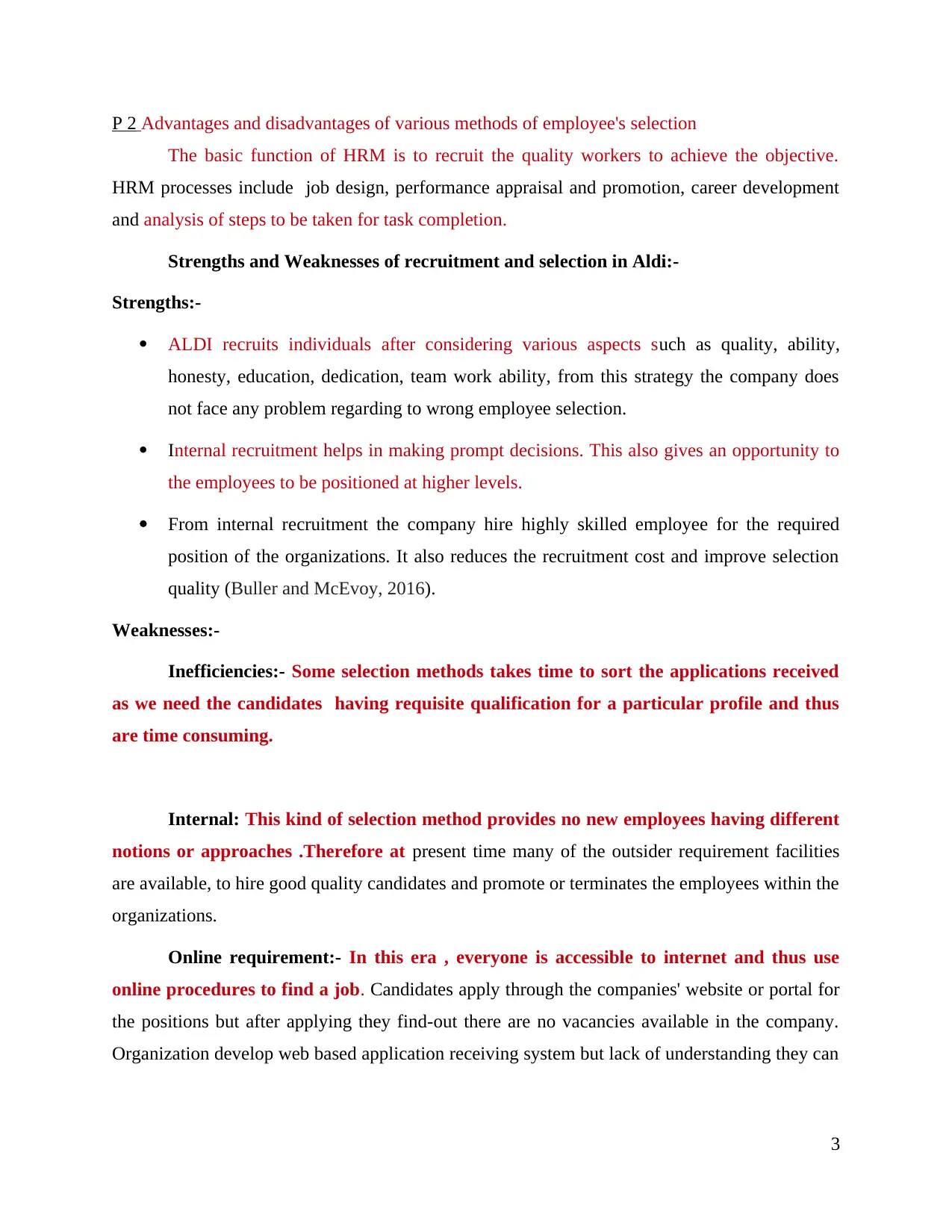
P 2 Advantages and disadvantages of various methods of employee's selection
The basic function of HRM is to recruit the quality workers to achieve the objective.
HRM processes include job design, performance appraisal and promotion, career development
and analysis of steps to be taken for task completion.
Strengths and Weaknesses of recruitment and selection in Aldi:-
Strengths:-
ALDI recruits individuals after considering various aspects such as quality, ability,
honesty, education, dedication, team work ability, from this strategy the company does
not face any problem regarding to wrong employee selection.
Internal recruitment helps in making prompt decisions. This also gives an opportunity to
the employees to be positioned at higher levels.
From internal recruitment the company hire highly skilled employee for the required
position of the organizations. It also reduces the recruitment cost and improve selection
quality (Buller and McEvoy, 2016).
Weaknesses:-
Inefficiencies:- Some selection methods takes time to sort the applications received
as we need the candidates having requisite qualification for a particular profile and thus
are time consuming.
Internal: This kind of selection method provides no new employees having different
notions or approaches .Therefore at present time many of the outsider requirement facilities
are available, to hire good quality candidates and promote or terminates the employees within the
organizations.
Online requirement:- In this era , everyone is accessible to internet and thus use
online procedures to find a job. Candidates apply through the companies' website or portal for
the positions but after applying they find-out there are no vacancies available in the company.
Organization develop web based application receiving system but lack of understanding they can
3
The basic function of HRM is to recruit the quality workers to achieve the objective.
HRM processes include job design, performance appraisal and promotion, career development
and analysis of steps to be taken for task completion.
Strengths and Weaknesses of recruitment and selection in Aldi:-
Strengths:-
ALDI recruits individuals after considering various aspects such as quality, ability,
honesty, education, dedication, team work ability, from this strategy the company does
not face any problem regarding to wrong employee selection.
Internal recruitment helps in making prompt decisions. This also gives an opportunity to
the employees to be positioned at higher levels.
From internal recruitment the company hire highly skilled employee for the required
position of the organizations. It also reduces the recruitment cost and improve selection
quality (Buller and McEvoy, 2016).
Weaknesses:-
Inefficiencies:- Some selection methods takes time to sort the applications received
as we need the candidates having requisite qualification for a particular profile and thus
are time consuming.
Internal: This kind of selection method provides no new employees having different
notions or approaches .Therefore at present time many of the outsider requirement facilities
are available, to hire good quality candidates and promote or terminates the employees within the
organizations.
Online requirement:- In this era , everyone is accessible to internet and thus use
online procedures to find a job. Candidates apply through the companies' website or portal for
the positions but after applying they find-out there are no vacancies available in the company.
Organization develop web based application receiving system but lack of understanding they can
3
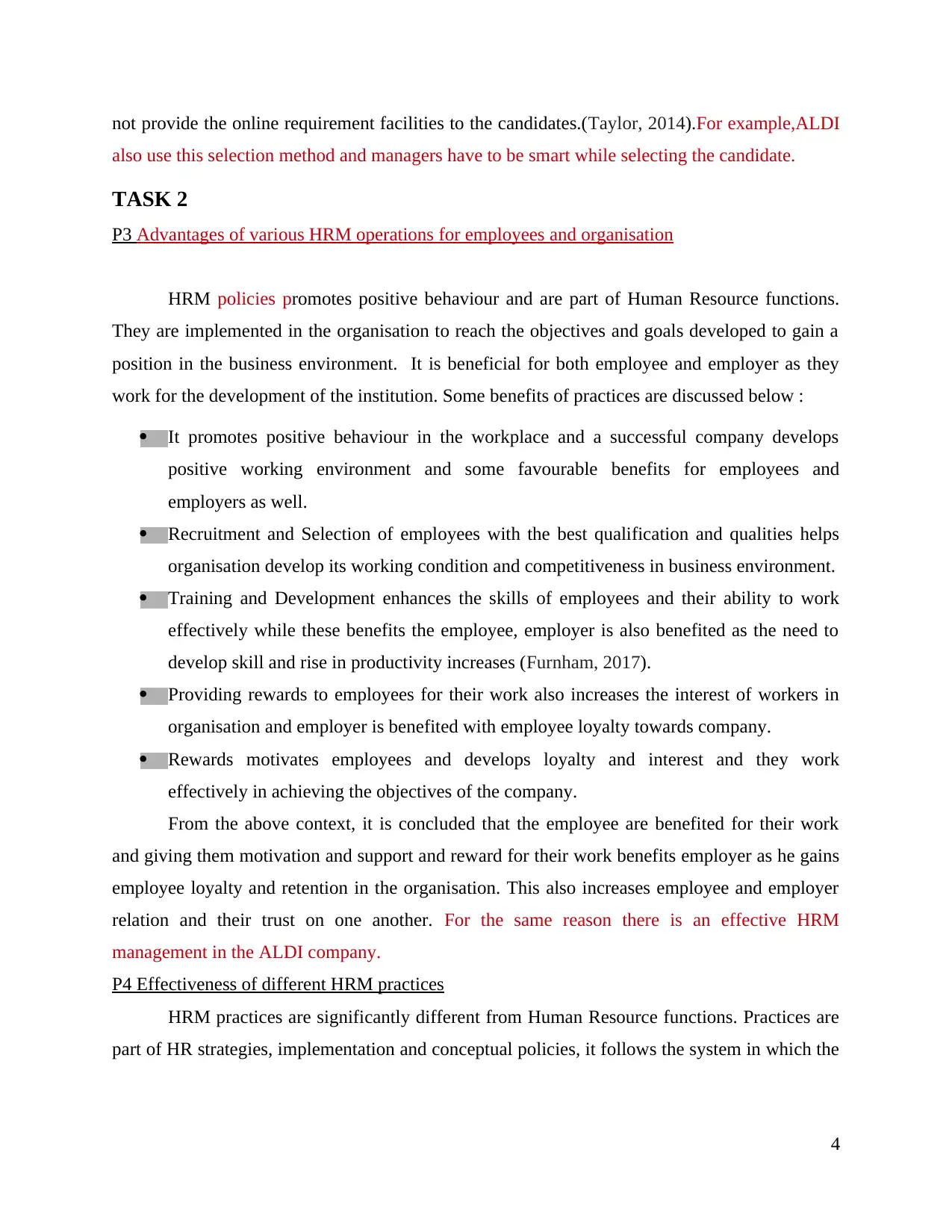
not provide the online requirement facilities to the candidates.(Taylor, 2014).For example,ALDI
also use this selection method and managers have to be smart while selecting the candidate.
TASK 2
P3 Advantages of various HRM operations for employees and organisation
HRM policies promotes positive behaviour and are part of Human Resource functions.
They are implemented in the organisation to reach the objectives and goals developed to gain a
position in the business environment. It is beneficial for both employee and employer as they
work for the development of the institution. Some benefits of practices are discussed below :
It promotes positive behaviour in the workplace and a successful company develops
positive working environment and some favourable benefits for employees and
employers as well.
Recruitment and Selection of employees with the best qualification and qualities helps
organisation develop its working condition and competitiveness in business environment.
Training and Development enhances the skills of employees and their ability to work
effectively while these benefits the employee, employer is also benefited as the need to
develop skill and rise in productivity increases (Furnham, 2017).
Providing rewards to employees for their work also increases the interest of workers in
organisation and employer is benefited with employee loyalty towards company.
Rewards motivates employees and develops loyalty and interest and they work
effectively in achieving the objectives of the company.
From the above context, it is concluded that the employee are benefited for their work
and giving them motivation and support and reward for their work benefits employer as he gains
employee loyalty and retention in the organisation. This also increases employee and employer
relation and their trust on one another. For the same reason there is an effective HRM
management in the ALDI company.
P4 Effectiveness of different HRM practices
HRM practices are significantly different from Human Resource functions. Practices are
part of HR strategies, implementation and conceptual policies, it follows the system in which the
4
also use this selection method and managers have to be smart while selecting the candidate.
TASK 2
P3 Advantages of various HRM operations for employees and organisation
HRM policies promotes positive behaviour and are part of Human Resource functions.
They are implemented in the organisation to reach the objectives and goals developed to gain a
position in the business environment. It is beneficial for both employee and employer as they
work for the development of the institution. Some benefits of practices are discussed below :
It promotes positive behaviour in the workplace and a successful company develops
positive working environment and some favourable benefits for employees and
employers as well.
Recruitment and Selection of employees with the best qualification and qualities helps
organisation develop its working condition and competitiveness in business environment.
Training and Development enhances the skills of employees and their ability to work
effectively while these benefits the employee, employer is also benefited as the need to
develop skill and rise in productivity increases (Furnham, 2017).
Providing rewards to employees for their work also increases the interest of workers in
organisation and employer is benefited with employee loyalty towards company.
Rewards motivates employees and develops loyalty and interest and they work
effectively in achieving the objectives of the company.
From the above context, it is concluded that the employee are benefited for their work
and giving them motivation and support and reward for their work benefits employer as he gains
employee loyalty and retention in the organisation. This also increases employee and employer
relation and their trust on one another. For the same reason there is an effective HRM
management in the ALDI company.
P4 Effectiveness of different HRM practices
HRM practices are significantly different from Human Resource functions. Practices are
part of HR strategies, implementation and conceptual policies, it follows the system in which the
4
⊘ This is a preview!⊘
Do you want full access?
Subscribe today to unlock all pages.

Trusted by 1+ million students worldwide
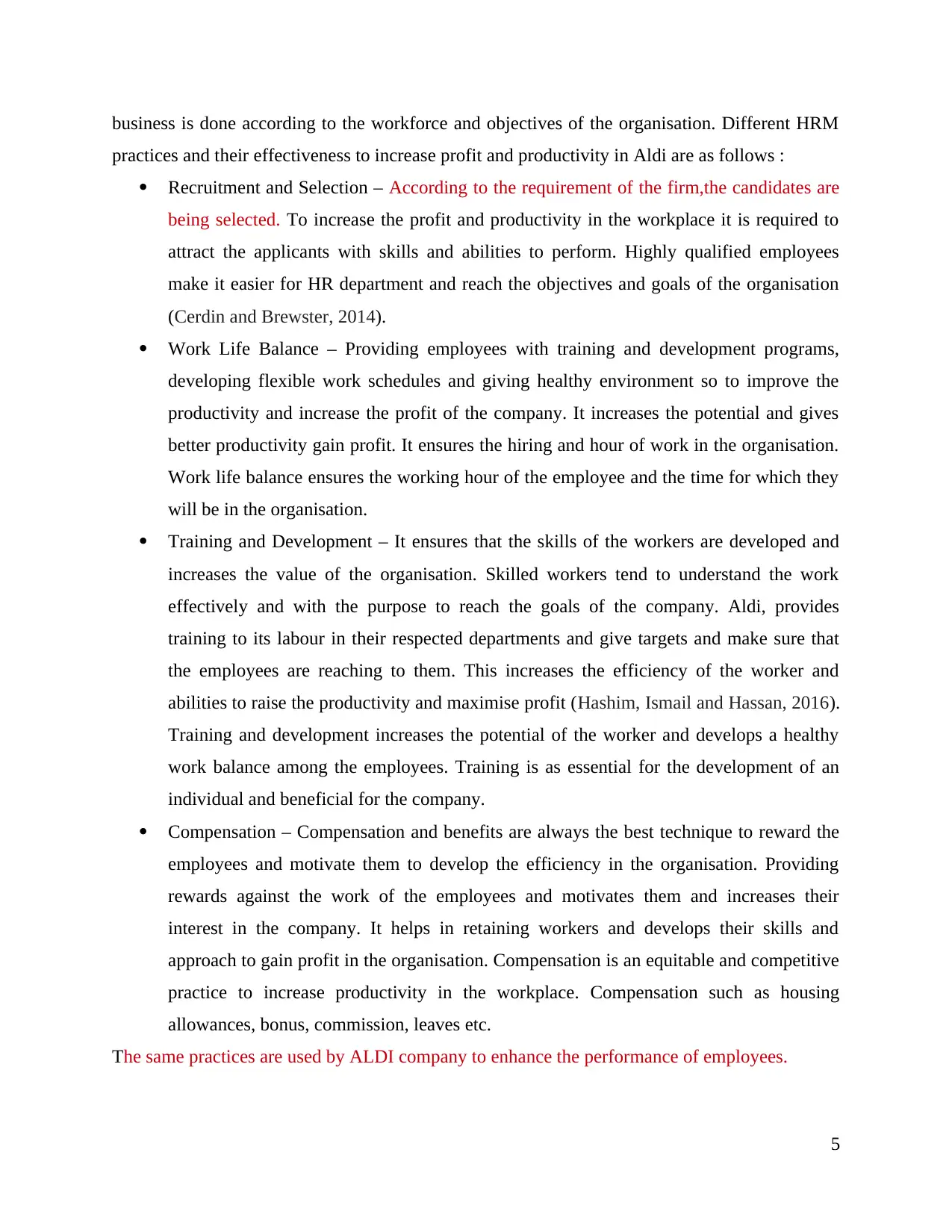
business is done according to the workforce and objectives of the organisation. Different HRM
practices and their effectiveness to increase profit and productivity in Aldi are as follows :
Recruitment and Selection – According to the requirement of the firm,the candidates are
being selected. To increase the profit and productivity in the workplace it is required to
attract the applicants with skills and abilities to perform. Highly qualified employees
make it easier for HR department and reach the objectives and goals of the organisation
(Cerdin and Brewster, 2014).
Work Life Balance – Providing employees with training and development programs,
developing flexible work schedules and giving healthy environment so to improve the
productivity and increase the profit of the company. It increases the potential and gives
better productivity gain profit. It ensures the hiring and hour of work in the organisation.
Work life balance ensures the working hour of the employee and the time for which they
will be in the organisation.
Training and Development – It ensures that the skills of the workers are developed and
increases the value of the organisation. Skilled workers tend to understand the work
effectively and with the purpose to reach the goals of the company. Aldi, provides
training to its labour in their respected departments and give targets and make sure that
the employees are reaching to them. This increases the efficiency of the worker and
abilities to raise the productivity and maximise profit (Hashim, Ismail and Hassan, 2016).
Training and development increases the potential of the worker and develops a healthy
work balance among the employees. Training is as essential for the development of an
individual and beneficial for the company.
Compensation – Compensation and benefits are always the best technique to reward the
employees and motivate them to develop the efficiency in the organisation. Providing
rewards against the work of the employees and motivates them and increases their
interest in the company. It helps in retaining workers and develops their skills and
approach to gain profit in the organisation. Compensation is an equitable and competitive
practice to increase productivity in the workplace. Compensation such as housing
allowances, bonus, commission, leaves etc.
The same practices are used by ALDI company to enhance the performance of employees.
5
practices and their effectiveness to increase profit and productivity in Aldi are as follows :
Recruitment and Selection – According to the requirement of the firm,the candidates are
being selected. To increase the profit and productivity in the workplace it is required to
attract the applicants with skills and abilities to perform. Highly qualified employees
make it easier for HR department and reach the objectives and goals of the organisation
(Cerdin and Brewster, 2014).
Work Life Balance – Providing employees with training and development programs,
developing flexible work schedules and giving healthy environment so to improve the
productivity and increase the profit of the company. It increases the potential and gives
better productivity gain profit. It ensures the hiring and hour of work in the organisation.
Work life balance ensures the working hour of the employee and the time for which they
will be in the organisation.
Training and Development – It ensures that the skills of the workers are developed and
increases the value of the organisation. Skilled workers tend to understand the work
effectively and with the purpose to reach the goals of the company. Aldi, provides
training to its labour in their respected departments and give targets and make sure that
the employees are reaching to them. This increases the efficiency of the worker and
abilities to raise the productivity and maximise profit (Hashim, Ismail and Hassan, 2016).
Training and development increases the potential of the worker and develops a healthy
work balance among the employees. Training is as essential for the development of an
individual and beneficial for the company.
Compensation – Compensation and benefits are always the best technique to reward the
employees and motivate them to develop the efficiency in the organisation. Providing
rewards against the work of the employees and motivates them and increases their
interest in the company. It helps in retaining workers and develops their skills and
approach to gain profit in the organisation. Compensation is an equitable and competitive
practice to increase productivity in the workplace. Compensation such as housing
allowances, bonus, commission, leaves etc.
The same practices are used by ALDI company to enhance the performance of employees.
5
Paraphrase This Document
Need a fresh take? Get an instant paraphrase of this document with our AI Paraphraser
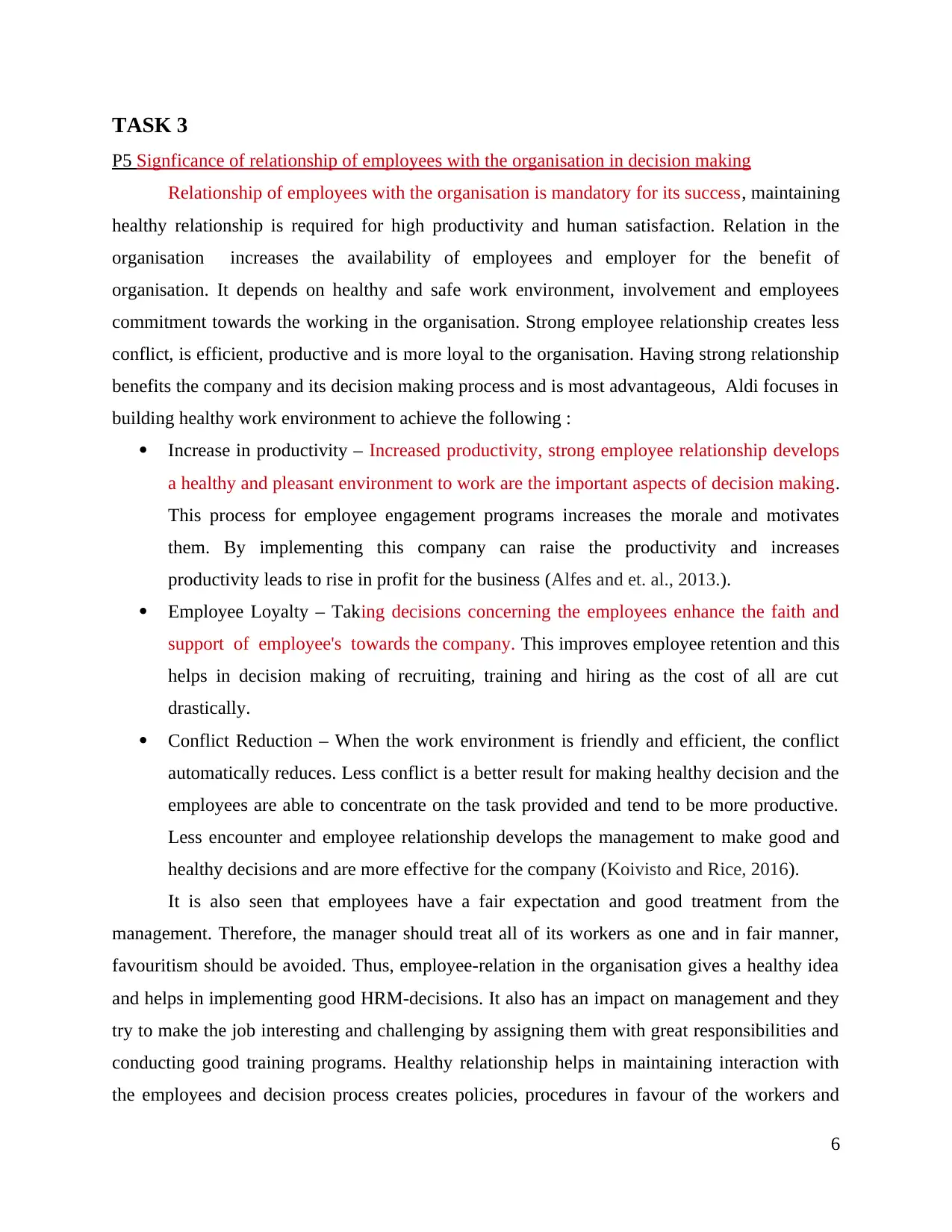
TASK 3
P5 Signficance of relationship of employees with the organisation in decision making
Relationship of employees with the organisation is mandatory for its success, maintaining
healthy relationship is required for high productivity and human satisfaction. Relation in the
organisation increases the availability of employees and employer for the benefit of
organisation. It depends on healthy and safe work environment, involvement and employees
commitment towards the working in the organisation. Strong employee relationship creates less
conflict, is efficient, productive and is more loyal to the organisation. Having strong relationship
benefits the company and its decision making process and is most advantageous, Aldi focuses in
building healthy work environment to achieve the following :
Increase in productivity – Increased productivity, strong employee relationship develops
a healthy and pleasant environment to work are the important aspects of decision making.
This process for employee engagement programs increases the morale and motivates
them. By implementing this company can raise the productivity and increases
productivity leads to rise in profit for the business (Alfes and et. al., 2013.).
Employee Loyalty – Taking decisions concerning the employees enhance the faith and
support of employee's towards the company. This improves employee retention and this
helps in decision making of recruiting, training and hiring as the cost of all are cut
drastically.
Conflict Reduction – When the work environment is friendly and efficient, the conflict
automatically reduces. Less conflict is a better result for making healthy decision and the
employees are able to concentrate on the task provided and tend to be more productive.
Less encounter and employee relationship develops the management to make good and
healthy decisions and are more effective for the company (Koivisto and Rice, 2016).
It is also seen that employees have a fair expectation and good treatment from the
management. Therefore, the manager should treat all of its workers as one and in fair manner,
favouritism should be avoided. Thus, employee-relation in the organisation gives a healthy idea
and helps in implementing good HRM-decisions. It also has an impact on management and they
try to make the job interesting and challenging by assigning them with great responsibilities and
conducting good training programs. Healthy relationship helps in maintaining interaction with
the employees and decision process creates policies, procedures in favour of the workers and
6
P5 Signficance of relationship of employees with the organisation in decision making
Relationship of employees with the organisation is mandatory for its success, maintaining
healthy relationship is required for high productivity and human satisfaction. Relation in the
organisation increases the availability of employees and employer for the benefit of
organisation. It depends on healthy and safe work environment, involvement and employees
commitment towards the working in the organisation. Strong employee relationship creates less
conflict, is efficient, productive and is more loyal to the organisation. Having strong relationship
benefits the company and its decision making process and is most advantageous, Aldi focuses in
building healthy work environment to achieve the following :
Increase in productivity – Increased productivity, strong employee relationship develops
a healthy and pleasant environment to work are the important aspects of decision making.
This process for employee engagement programs increases the morale and motivates
them. By implementing this company can raise the productivity and increases
productivity leads to rise in profit for the business (Alfes and et. al., 2013.).
Employee Loyalty – Taking decisions concerning the employees enhance the faith and
support of employee's towards the company. This improves employee retention and this
helps in decision making of recruiting, training and hiring as the cost of all are cut
drastically.
Conflict Reduction – When the work environment is friendly and efficient, the conflict
automatically reduces. Less conflict is a better result for making healthy decision and the
employees are able to concentrate on the task provided and tend to be more productive.
Less encounter and employee relationship develops the management to make good and
healthy decisions and are more effective for the company (Koivisto and Rice, 2016).
It is also seen that employees have a fair expectation and good treatment from the
management. Therefore, the manager should treat all of its workers as one and in fair manner,
favouritism should be avoided. Thus, employee-relation in the organisation gives a healthy idea
and helps in implementing good HRM-decisions. It also has an impact on management and they
try to make the job interesting and challenging by assigning them with great responsibilities and
conducting good training programs. Healthy relationship helps in maintaining interaction with
the employees and decision process creates policies, procedures in favour of the workers and
6
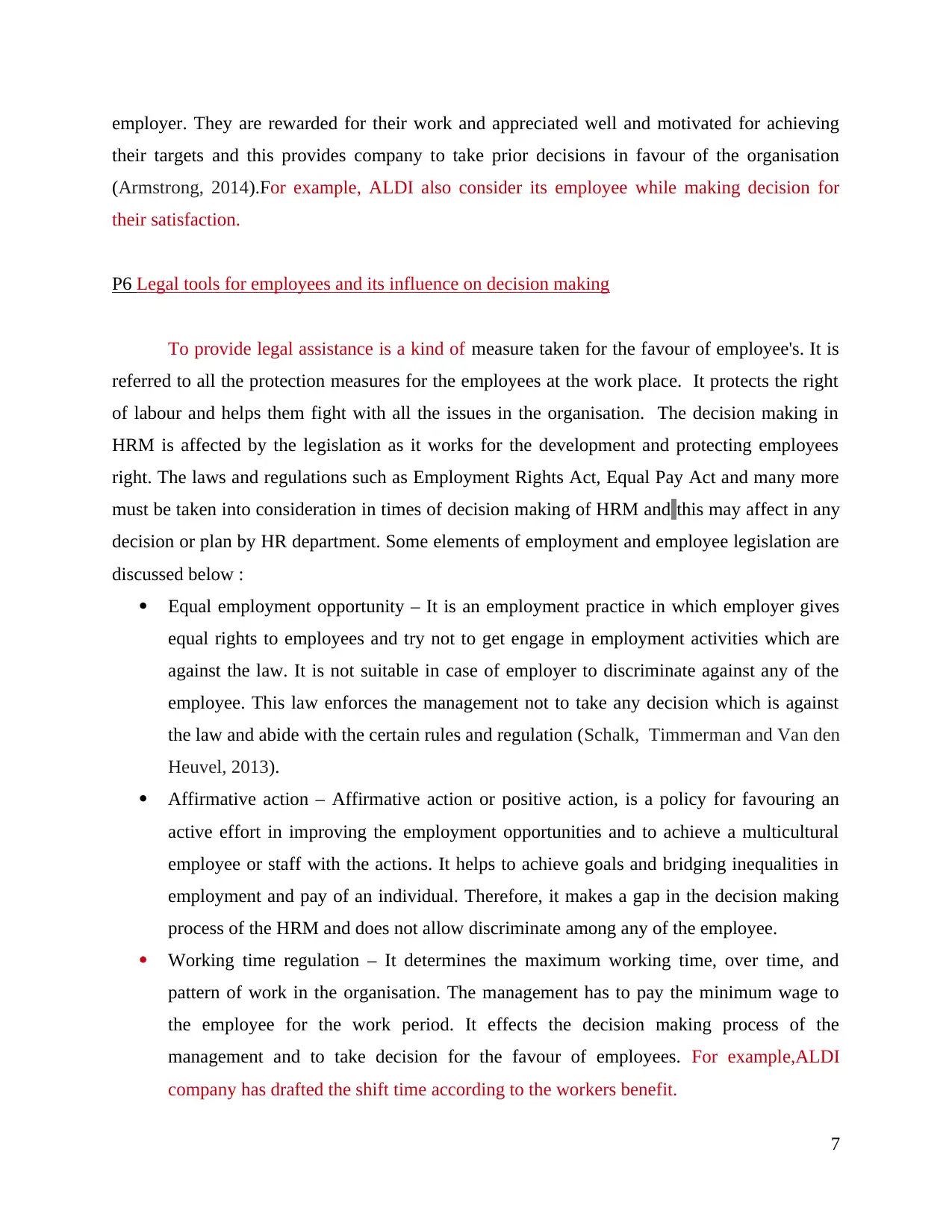
employer. They are rewarded for their work and appreciated well and motivated for achieving
their targets and this provides company to take prior decisions in favour of the organisation
(Armstrong, 2014).For example, ALDI also consider its employee while making decision for
their satisfaction.
P6 Legal tools for employees and its influence on decision making
To provide legal assistance is a kind of measure taken for the favour of employee's. It is
referred to all the protection measures for the employees at the work place. It protects the right
of labour and helps them fight with all the issues in the organisation. The decision making in
HRM is affected by the legislation as it works for the development and protecting employees
right. The laws and regulations such as Employment Rights Act, Equal Pay Act and many more
must be taken into consideration in times of decision making of HRM and this may affect in any
decision or plan by HR department. Some elements of employment and employee legislation are
discussed below :
Equal employment opportunity – It is an employment practice in which employer gives
equal rights to employees and try not to get engage in employment activities which are
against the law. It is not suitable in case of employer to discriminate against any of the
employee. This law enforces the management not to take any decision which is against
the law and abide with the certain rules and regulation (Schalk, Timmerman and Van den
Heuvel, 2013).
Affirmative action – Affirmative action or positive action, is a policy for favouring an
active effort in improving the employment opportunities and to achieve a multicultural
employee or staff with the actions. It helps to achieve goals and bridging inequalities in
employment and pay of an individual. Therefore, it makes a gap in the decision making
process of the HRM and does not allow discriminate among any of the employee.
Working time regulation – It determines the maximum working time, over time, and
pattern of work in the organisation. The management has to pay the minimum wage to
the employee for the work period. It effects the decision making process of the
management and to take decision for the favour of employees. For example,ALDI
company has drafted the shift time according to the workers benefit.
7
their targets and this provides company to take prior decisions in favour of the organisation
(Armstrong, 2014).For example, ALDI also consider its employee while making decision for
their satisfaction.
P6 Legal tools for employees and its influence on decision making
To provide legal assistance is a kind of measure taken for the favour of employee's. It is
referred to all the protection measures for the employees at the work place. It protects the right
of labour and helps them fight with all the issues in the organisation. The decision making in
HRM is affected by the legislation as it works for the development and protecting employees
right. The laws and regulations such as Employment Rights Act, Equal Pay Act and many more
must be taken into consideration in times of decision making of HRM and this may affect in any
decision or plan by HR department. Some elements of employment and employee legislation are
discussed below :
Equal employment opportunity – It is an employment practice in which employer gives
equal rights to employees and try not to get engage in employment activities which are
against the law. It is not suitable in case of employer to discriminate against any of the
employee. This law enforces the management not to take any decision which is against
the law and abide with the certain rules and regulation (Schalk, Timmerman and Van den
Heuvel, 2013).
Affirmative action – Affirmative action or positive action, is a policy for favouring an
active effort in improving the employment opportunities and to achieve a multicultural
employee or staff with the actions. It helps to achieve goals and bridging inequalities in
employment and pay of an individual. Therefore, it makes a gap in the decision making
process of the HRM and does not allow discriminate among any of the employee.
Working time regulation – It determines the maximum working time, over time, and
pattern of work in the organisation. The management has to pay the minimum wage to
the employee for the work period. It effects the decision making process of the
management and to take decision for the favour of employees. For example,ALDI
company has drafted the shift time according to the workers benefit.
7
⊘ This is a preview!⊘
Do you want full access?
Subscribe today to unlock all pages.

Trusted by 1+ million students worldwide
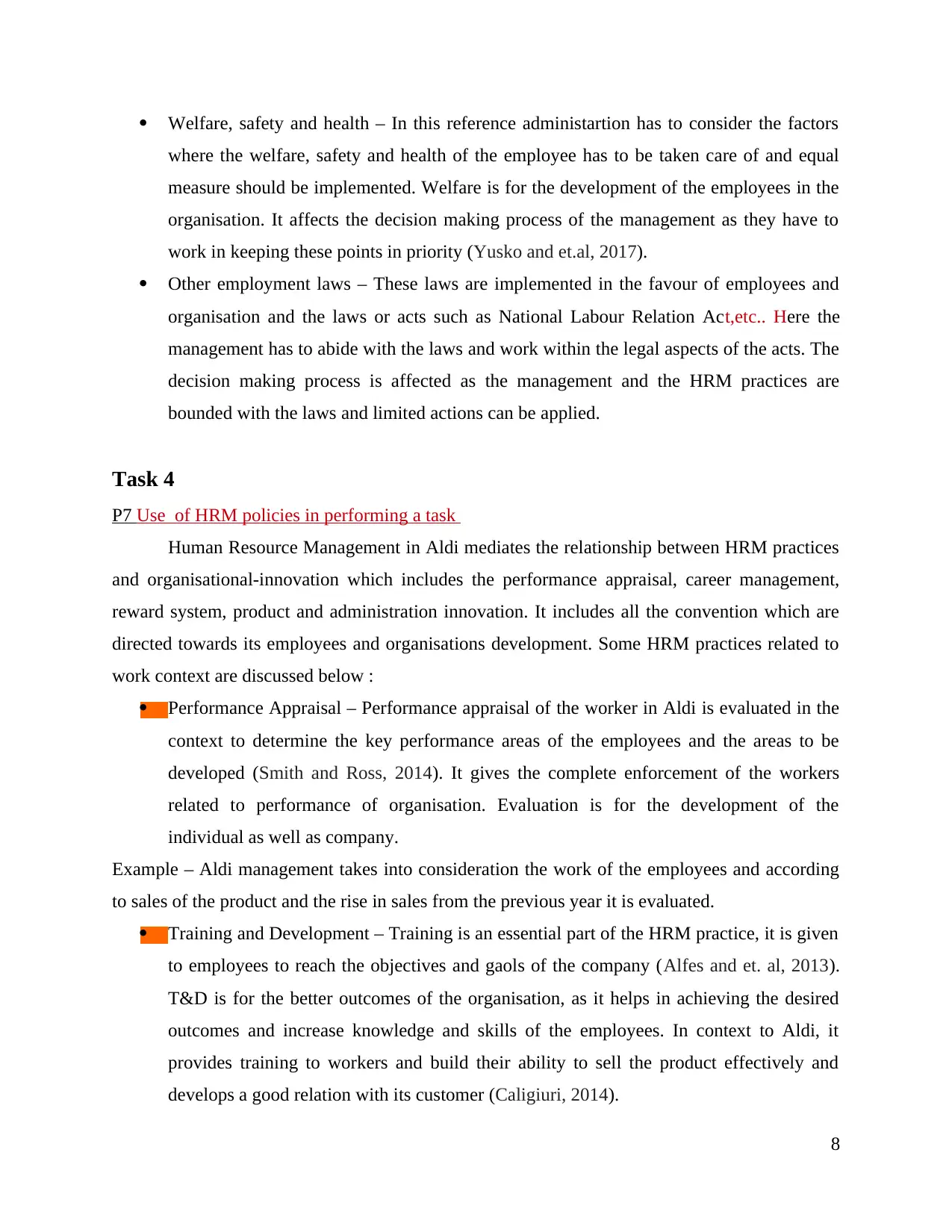
Welfare, safety and health – In this reference administartion has to consider the factors
where the welfare, safety and health of the employee has to be taken care of and equal
measure should be implemented. Welfare is for the development of the employees in the
organisation. It affects the decision making process of the management as they have to
work in keeping these points in priority (Yusko and et.al, 2017).
Other employment laws – These laws are implemented in the favour of employees and
organisation and the laws or acts such as National Labour Relation Act,etc.. Here the
management has to abide with the laws and work within the legal aspects of the acts. The
decision making process is affected as the management and the HRM practices are
bounded with the laws and limited actions can be applied.
Task 4
P7 Use of HRM policies in performing a task
Human Resource Management in Aldi mediates the relationship between HRM practices
and organisational-innovation which includes the performance appraisal, career management,
reward system, product and administration innovation. It includes all the convention which are
directed towards its employees and organisations development. Some HRM practices related to
work context are discussed below :
Performance Appraisal – Performance appraisal of the worker in Aldi is evaluated in the
context to determine the key performance areas of the employees and the areas to be
developed (Smith and Ross, 2014). It gives the complete enforcement of the workers
related to performance of organisation. Evaluation is for the development of the
individual as well as company.
Example – Aldi management takes into consideration the work of the employees and according
to sales of the product and the rise in sales from the previous year it is evaluated.
Training and Development – Training is an essential part of the HRM practice, it is given
to employees to reach the objectives and gaols of the company (Alfes and et. al, 2013).
T&D is for the better outcomes of the organisation, as it helps in achieving the desired
outcomes and increase knowledge and skills of the employees. In context to Aldi, it
provides training to workers and build their ability to sell the product effectively and
develops a good relation with its customer (Caligiuri, 2014).
8
where the welfare, safety and health of the employee has to be taken care of and equal
measure should be implemented. Welfare is for the development of the employees in the
organisation. It affects the decision making process of the management as they have to
work in keeping these points in priority (Yusko and et.al, 2017).
Other employment laws – These laws are implemented in the favour of employees and
organisation and the laws or acts such as National Labour Relation Act,etc.. Here the
management has to abide with the laws and work within the legal aspects of the acts. The
decision making process is affected as the management and the HRM practices are
bounded with the laws and limited actions can be applied.
Task 4
P7 Use of HRM policies in performing a task
Human Resource Management in Aldi mediates the relationship between HRM practices
and organisational-innovation which includes the performance appraisal, career management,
reward system, product and administration innovation. It includes all the convention which are
directed towards its employees and organisations development. Some HRM practices related to
work context are discussed below :
Performance Appraisal – Performance appraisal of the worker in Aldi is evaluated in the
context to determine the key performance areas of the employees and the areas to be
developed (Smith and Ross, 2014). It gives the complete enforcement of the workers
related to performance of organisation. Evaluation is for the development of the
individual as well as company.
Example – Aldi management takes into consideration the work of the employees and according
to sales of the product and the rise in sales from the previous year it is evaluated.
Training and Development – Training is an essential part of the HRM practice, it is given
to employees to reach the objectives and gaols of the company (Alfes and et. al, 2013).
T&D is for the better outcomes of the organisation, as it helps in achieving the desired
outcomes and increase knowledge and skills of the employees. In context to Aldi, it
provides training to workers and build their ability to sell the product effectively and
develops a good relation with its customer (Caligiuri, 2014).
8
Paraphrase This Document
Need a fresh take? Get an instant paraphrase of this document with our AI Paraphraser
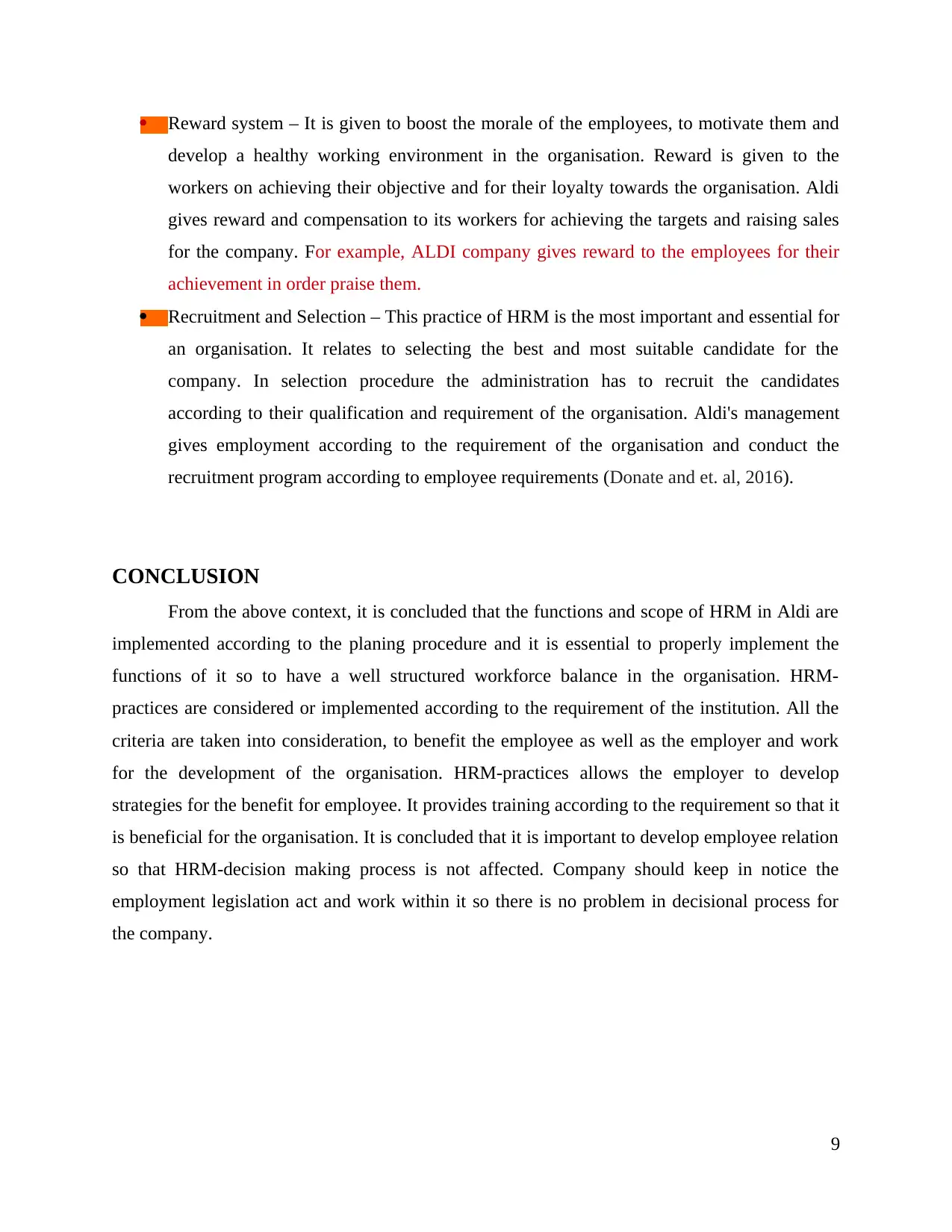
Reward system – It is given to boost the morale of the employees, to motivate them and
develop a healthy working environment in the organisation. Reward is given to the
workers on achieving their objective and for their loyalty towards the organisation. Aldi
gives reward and compensation to its workers for achieving the targets and raising sales
for the company. For example, ALDI company gives reward to the employees for their
achievement in order praise them.
Recruitment and Selection – This practice of HRM is the most important and essential for
an organisation. It relates to selecting the best and most suitable candidate for the
company. In selection procedure the administration has to recruit the candidates
according to their qualification and requirement of the organisation. Aldi's management
gives employment according to the requirement of the organisation and conduct the
recruitment program according to employee requirements (Donate and et. al, 2016).
CONCLUSION
From the above context, it is concluded that the functions and scope of HRM in Aldi are
implemented according to the planing procedure and it is essential to properly implement the
functions of it so to have a well structured workforce balance in the organisation. HRM-
practices are considered or implemented according to the requirement of the institution. All the
criteria are taken into consideration, to benefit the employee as well as the employer and work
for the development of the organisation. HRM-practices allows the employer to develop
strategies for the benefit for employee. It provides training according to the requirement so that it
is beneficial for the organisation. It is concluded that it is important to develop employee relation
so that HRM-decision making process is not affected. Company should keep in notice the
employment legislation act and work within it so there is no problem in decisional process for
the company.
9
develop a healthy working environment in the organisation. Reward is given to the
workers on achieving their objective and for their loyalty towards the organisation. Aldi
gives reward and compensation to its workers for achieving the targets and raising sales
for the company. For example, ALDI company gives reward to the employees for their
achievement in order praise them.
Recruitment and Selection – This practice of HRM is the most important and essential for
an organisation. It relates to selecting the best and most suitable candidate for the
company. In selection procedure the administration has to recruit the candidates
according to their qualification and requirement of the organisation. Aldi's management
gives employment according to the requirement of the organisation and conduct the
recruitment program according to employee requirements (Donate and et. al, 2016).
CONCLUSION
From the above context, it is concluded that the functions and scope of HRM in Aldi are
implemented according to the planing procedure and it is essential to properly implement the
functions of it so to have a well structured workforce balance in the organisation. HRM-
practices are considered or implemented according to the requirement of the institution. All the
criteria are taken into consideration, to benefit the employee as well as the employer and work
for the development of the organisation. HRM-practices allows the employer to develop
strategies for the benefit for employee. It provides training according to the requirement so that it
is beneficial for the organisation. It is concluded that it is important to develop employee relation
so that HRM-decision making process is not affected. Company should keep in notice the
employment legislation act and work within it so there is no problem in decisional process for
the company.
9
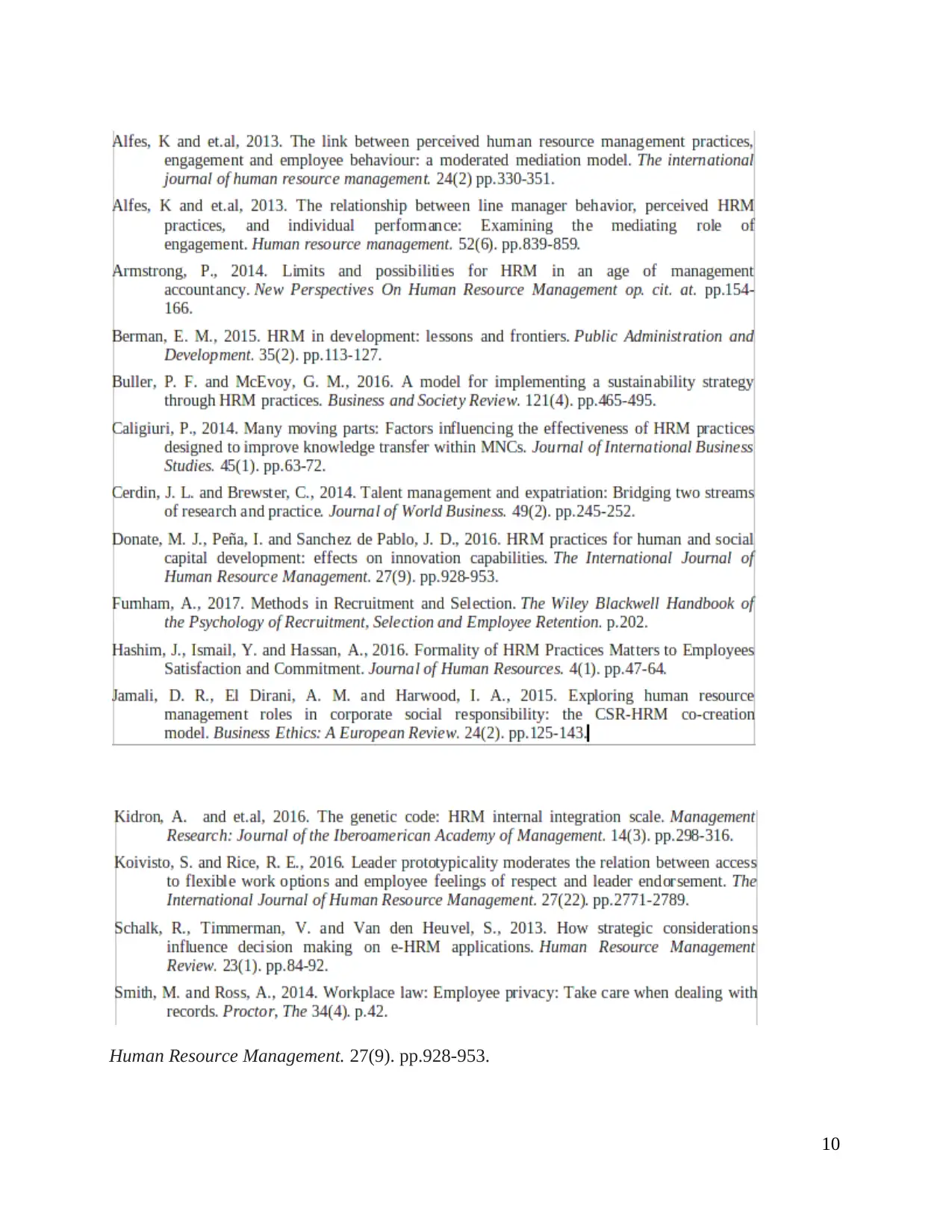
Human Resource Management. 27(9). pp.928-953.
10
10
⊘ This is a preview!⊘
Do you want full access?
Subscribe today to unlock all pages.

Trusted by 1+ million students worldwide
1 out of 12
Related Documents
Your All-in-One AI-Powered Toolkit for Academic Success.
+13062052269
info@desklib.com
Available 24*7 on WhatsApp / Email
![[object Object]](/_next/static/media/star-bottom.7253800d.svg)
Unlock your academic potential
Copyright © 2020–2025 A2Z Services. All Rights Reserved. Developed and managed by ZUCOL.




